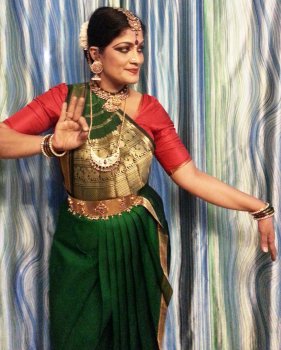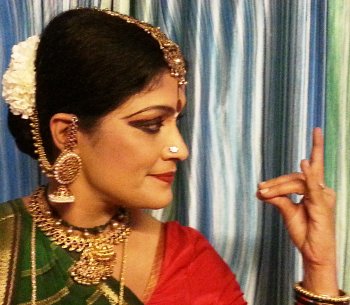
|   |

|   |
Bhakti nritya - Shveta Arora e-mail: shwetananoop@gmail.com December 20, 2013 At heart she is a bhakt, and her dance reflects the inner devotion. Geeta Chandran performed at the Ayyappa temple in Delhi on 7th December, in a program titled ‘Bhakti Manjari’ where she presented traditional items from her classical repertoire that showcases the temple origins of Bharatanatyam.  Her sweating in the month of December shows how much an effort it takes to give a perfect performance, talking about which, she said, “The varnam has been with me for twenty years. I have visited it quite a few times and two years back, I performed it at Kalakshetra. It is a favourite of my guru. The raga Karaharapriya is a beautiful one. This varnam has every single emotion that can be imagined of the nayika in love. Dance is an extension of one’s self and I always feel while revisiting this varnam that I encounter something that I have experienced. So many layers keep opening up. The musicians also say that it was so different from what has been rehearsed. You flow with the stage, the audience, the aura and the mood of that day. I was not able to fathom this when my guru said that you improvise on stage, but now I know how it happens.” The first piece was Ayyappa kirtanam in ragam Gowli, adi talam, composed by Vidvan N Krishnan. Next was a panchakshara stotram, a Shiva stuti, expanding on the five syllables – na, ma, shi, va and ya. She presented the philosophy hidden behind each of these syllables. Na is feet, ma is nabhi, shi is shoulder, va is face and ya is hair. It was composed by Adi Shankaracharya as an invocation. The stotram has been revisited by Geeta a few times. Lord Shiva is worshipped as Nagendraharaye, Trilochanaye, Maheshwaraye, Digamberaye, Neelkanthaye, Yakshaswaroopaye, Gangadharaye and Jatadharaye. Geeta portrayed the magnificence of the lord and all these attributes with perfect abhinaya, gestures and balancing stances. This was followed by a Devi stuti - Amba Shambhavi, showing the aspects of the divine feminine energy based on imagery from the Markandeya Puranam. The Goddess is the mother, sister, and consort. She is the mother earth. On the one hand, she is attributed with beauty and karuna, and on the other, she is ferocious enough to fight evil. Amba, Shambhavi, Chandramouli, Abla, Aparna, Uma, Parvati, Kali, Hemavati, Trinayani, Katyayani, Bhairavi, Savitri, Lakshmi, Raudrakarini, Jwalamukhi, Vaishnavi, Chamundi, Bhagwati and Rajarajeshwari – each of these names depicted in dance are diverse avatars of Devi in different forms, with opposing attributes. Each was depicted by Geeta through flawless gestures and stances, having the desired effect of revering the Devi in her various forms.  The following piece was a varnam in a beautiful blend of nritta with all its energy, and abhinaya with all its subtleties. The nayika, who is in love with Lord Shiva, tells her sakhi that her heart is overflowing with passion for him. “Madana is tormenting me,” says the nayika, “My Lord, who is the great yogi at Chidambaram, whose yoga is the grand dance with one foot raised? Will he come to serenade me today? Today the lovely moon, which was once witness to our love, is tormenting me with harsh fire-like rays. My heart is withering with longing, O friend, do go and bring my ishta devata to me. O sakhi, I have none to fear. I love Shiva and openly declare my love for him.” The interspersed nritta had a lot of energy and technique. The nayika, who was depicted collecting flowers in the forest while she enjoys the rain and the song of the cuckoo, talks about her longing. The abhinaya ended with the heroine’s unabashed declaration of her love. The varnam was a composition of the Late K.N. Dandayudhapani Pillai. Geeta then danced a moving Thyagaraja composition in ragam Varali, mishra chapu talam. The verse is about longing that a devotee experiences after years of prayer. “O Lord, what is the meaning of my life if I cannot see you and interact with you? My life is meaningless if I cannot gaze at your lotus face, more radiant than a million cupids. I long to gaze at you afloat in the cosmic ocean of milk, resting on Adisesha. My mind is in turmoil, O Rama, do not delay in revealing yourself to me.” Geeta’s highly inspired abhinaya depicted the emotion of yearning. Life is not about eating and sleeping. The bigger purpose is of worshipping Lord Rama, who has meen nayan, a parrot-like nose and lips like bimba-phal. The reclining Lord was depicted by a balancing stance. The emotion portrayed was that of a devotee worshipping the lord, not for any material gain, but only to have a glimpse of him. But even after a lifetime of selfless praying, he does not get a glimpse of his ishta devata. His heart is filled with sorrow and bleeds with viraha when out of his desperation, he speaks to his lord. Geeta then concluded her performance with the sankirtan Vanamali vasudeva jagamohan radha ramana. “The Thyagaraja composition that I performed, I do not do it on stage often since the poetry is heart wrenching. He is a vaggeyakara and he must have written it at a very poignant moment in his life when he must have reached a dead end, asking his lord if he is ever going to give him a glimpse. A lengthy composition may not take so much of an effort as this one does as it just goes inside you and wrenches you. It feels as if you are talking to that divine spirit and asking for some kind of light on your path. So I do it at home but on the stage with so many other things going on, I don’t do it. This being a temple and a sacred space, I performed it here. It is an intense piece coming from a very spiritual plane.” Shveta Arora is a blogger based in Delhi. She writes about cultural events in the capital. |